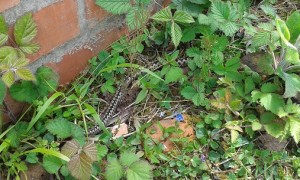
Snakes have often been historically described as ‘cold-blooded, venomous and evil’. Today however many people are fascinated by these intriguing creatures and a sighting of one of our native reptiles, which are in fact secretive and shy, can be very exciting. We can help develop this enthusiasm to educate and nurture a respect for snakes through fun facts and outdoor activities.
Meet the snakes:
There are six native reptiles in Britain. Three snake – adder, grass snake and smooth snake, and three lizard – slow worm, common and sand lizard. The New Forest is home to all six, which includes the nationally endangered smooth snake and sand lizard.
- Smooth snake – very rare and found only in heathlands in southern England. It is a slender snake with smooth flat scales. Sometimes mistaken for a slow worm which is a legless lizard.
- Grass snake – our longest snake, up to 1 m in length, with a distinctive yellow and black collar around the neck. It is a common visitor to gardens with compost heaps, where females lay their eggs, and hunt by ponds.
- Adder – our only venomous snake and is very rarely seen in gardens. Prefers heathland habitats, such as the New Forest. It has a distinctive dark zig-zag pattern running down its back on a body of grey or brown. Adders are very timid and non-aggressive. Their venom is only used to kill small mammals like voles.
Reptile watching tips:
When to look: Part of a snake’s mystique is its ‘cold-blooded’ nature. As reptiles they cannot generate their own body heat. They need to bask in the sun to raise their body temperature. So the best time to look for snakes is before or after it becomes hot in the middle of a sunny day, when they are basking or shading themselves to cool down.
Where to look: Snakes keep to their preferred habitat. Good places to look for adders are sandy heathlands and alongside sheltered walls, hedgerows and woodland glades. Grass snakes are associated with water such as ponds, lakes and marshy areas.
Move quietly: Snakes do have ears but respond to movement rather than sound, so once they have warmed up they move quick. Often you only hear the rustles of vegetation as they slither away.
Use binoculars: Important visual details can be seen without disturbing snakes. For example, an adder’s eye has a vertical slit of a pupil which is best observed from a safe distance through binoculars!
Remember reptiles are protected by law and no wild reptile should be handled. Be especially cautious around adders as they are venomous and although bites are rare they do require medical attention.
Fun snake facts:
- Snakes don’t have eye lids – so they can’t wink at you like lizards can!
- Snakes smell with their tongue.
- Their scaly skin is waterproof and they shed or ‘slough’ their skins as they grow larger. You might be lucky enough to find one. Look for the transparent scale covering the eye called a spectacle.
- Grass snakes can swim – they love hunting in ponds for amphibians and fish.
- Snakes can’t bite food so they swallow their prey head first! They have flexible jaws (not fused like ours) that allow them to eat prey larger than their head.
Activities and projects:
Reptile habitat survey: How reptile friendly is your wild space? Give points for each feature, for example: wildlife pond, areas of long and short grass, open compost heap, log pile and rockery. 5+ points – well done!
Spiral snakes: Draw a curled up snake on paper and cut out to form a spiral body. Create scales by placing netting from fruit bags under the paper and rub over the top using a wax crayon. Beautiful scale patterns will appear and the wax also feels like reptile scales. Make them life sized and colour them accurately – markings and eye colour are important identification features.
Helping hand: Reptiles are increasingly vulnerable to habitat loss. Build a south facing dry-stone wall or mini cairn. A compost heap is easy to establish and a pond benefits amphibians too. For lots of great advice check out www.froglife.org and www.arc-trust.org
Visit the New Forest Reptile Centre: Located near Lyndhurst in the New Forest, where all six native reptiles can be seen. There is information and a trail and volunteers are on hand to help get the most from your visit. A good site for group visits.
